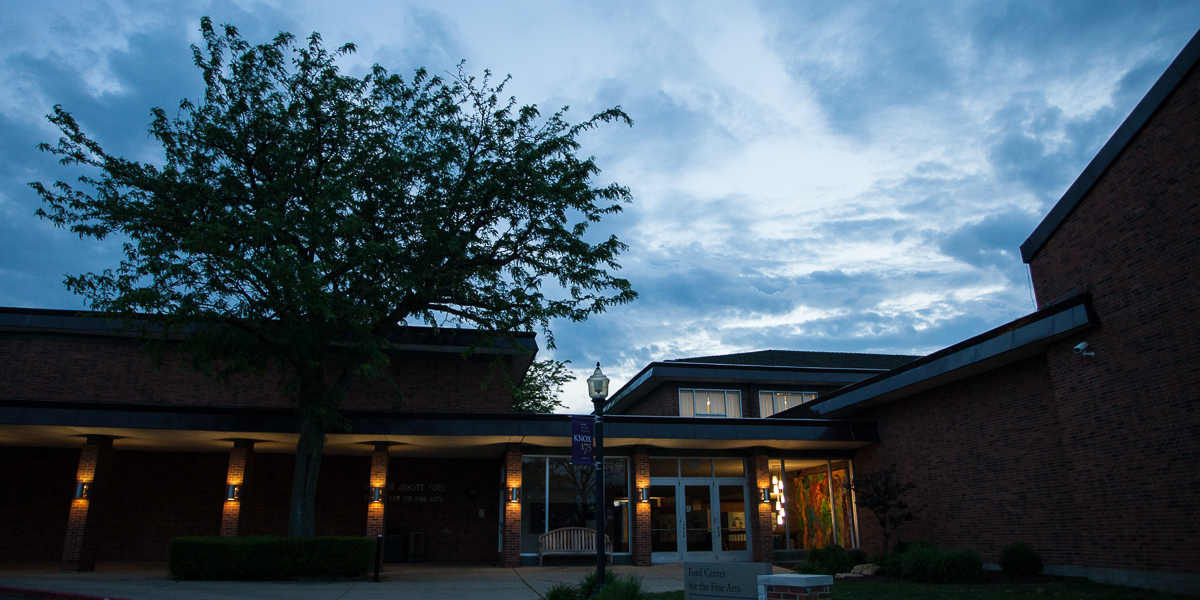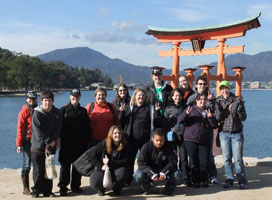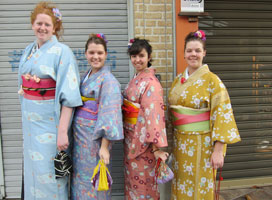

Venture Boldly

Adriana Colindres
Features Editor
2 East South Street
Galesburg, IL 61401

Fourteen Knox College students recently found a foolproof way to attract attention in Japan: Walk through city streets and ride a public bus while dressed in a traditional Japanese kimono.
It was one of many memorable experiences for the students, who spent two weeks in the Asian country as part of Japan Term, an interdisciplinary program that involves studying Japanese history, philosophy, and language.
"The Japanese people were really enthusiastic to our whole group wearing kimonos," said Justin Dingle, a sophomore from Homewood, Illinois.
Shaun Kelly, a sophomore from Columbia, Missouri, said the sight of American college students in the gown-like kimonos inspired a variety of reactions from onlookers. Some pretended not to look at them, she said. Others offered compliments, saying: "Wow! That really suits you." Many took their photos.
"It was fun being a tourist -- and a tourist attraction -- in Japan," said Melissa Sher, a junior from Vernon Hills, Illinois. "I think we had a group from Malaysia come take pictures of us for five minutes."
The situation provided a good opportunity for the Knox students to practice their language skills with native Japanese speakers.
"When I was wearing kimono, a lot more people were trying to speak to me in Japanese, and they seemed more pleased when I managed to respond in Japanese," said Stephanie Charvat, a sophomore from Lombard, Illinois.
Interested in learning more about Japan Term? Here are a few questions and answers:
Q: Where did the Japan Term students go, and what did they do?
A: They spent most of their time in Tokyo, Kyoto, and Hiroshima, also making day trips to other places, such as Nara and Miyajima. They visited numerous sites, including Buddhist temples, Shinto shrines, and the Hiroshima Peace Memorial Museum.
 Japan Term faculty members assigned the students specific exercises. For example, they had to ask a Japanese person to take their photo. Students also had some free time, providing them a chance to explore a bit on their own. Some pursued research projects.
Japan Term faculty members assigned the students specific exercises. For example, they had to ask a Japanese person to take their photo. Students also had some free time, providing them a chance to explore a bit on their own. Some pursued research projects.
Three Knox faculty members accompanied the students. They were Michael Schneider, professor of history and director of Knox's Eleanor Stellyes Center for Global Studies; William Young, associate professor of philosophy; and Kaori Furuya, visiting assistant professor of Asian Studies.
Q: Other than the kimono-wearing experience, what were some of their favorite moments in Japan?
A: Several students were impressed with their day trip to Miyajima, a picturesque island that is considered sacred ground.
"I'm a huge sucker for forests and mountains and scenic views," said Brynn Ogilvie, a junior from Olympia, Washington. "The deer would actually come up to you and try to get food."
Dingle mentioned a visit to a temple that houses the largest Buddha sculpture in the world.
"If I was just a tourist, I would have gone there and thought, ‘Oh, that's a pretty big Buddha.' But in the Buddhism class (that was part of Japan Term), we learned about the history behind it," he said.
Q: Do Japan Term students plan to continue learning about Japan?
A: Yes. Many of them have enrolled in the Japan Term II class, which builds on their earlier knowledge, and some already have started making plans to return to the country.
For example, Kelly hopes to spend next year studying abroad in Tokyo. "Hopefully, that will be the next step for my language (skills) and cultural understanding," she said, adding that she wants to experience life in Japan "without living out of a suitcase."
After graduating from Knox, Sher would like to participate in the Japanese Exchange and Teaching (JET) program and work as an English-language teaching assistant in a high school or junior high school in Japan.
Founded in 1837, Knox is a national liberal arts college in Galesburg, Illinois, with students from 45 states and 48 countries. Knox's "Old Main" is a National Historic Landmark and the only building remaining from the 1858 Lincoln-Douglas debates.
(Photo at top of page: Schneider, Young and some Japan Term students at a kimono restaurant in Kyoto. Above left: The Japan Term group stands in front of the Torii, or Gateway, at Miyajima. Above right: Knox students model women's kimonos in Kyoto. Photos courtesy of Justin Dingle and Shaun Kelly. )
Published on January 31, 2011